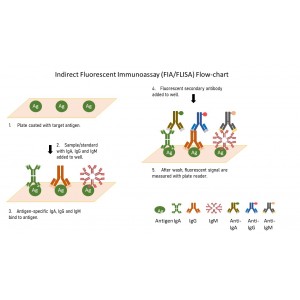Data sheet
| Assay time | 2.5 hours |
| Specificity | Human H.pylori IgA, IgG, and IgM |
| Background | Helicobacter pylori is a spiral bacterium cultured from human gastric mucosa by Marshall in 1982. Studies have indicated that the presence of H. pylori is associated with a variety of gastrointestinal diseases including gastritis, duodenal and gastric ulcer, non-ulcer dyspepsia, gastric adenocarcinoma and lymphoma. The organism is present in 95-98% of patients with duodenal ulcer and 60-90% of patients with gastric ulcers. The studies have also demonstrated that removal of the organism by antimicrobial therapy is correlated with the resolution of symptoms and cure of diseases. Patients who present with clinical symptoms relating to the gastrointestinal tract can be diagnosed for H. pylori infection by two methods: 1) invasive techniques include biopsy followed by culture or histologic examination of biopsy specimen or direct detection of urease activity. 2) non-invasive techniques include urea breath tests, serological methods and stool antigen test. All of the testing performed on biopsy samples are subject to errors related to sampling and interference of contaminated bacteria. H. pylori IgA, IgG, and IgM testing the presence of H. pylori specific IgA, IgG and IgM antibody is the technique of choice for serologic tests because of its accuracy and simplicity. |
| Assay principle | The Human IgA, IgG, and IgM Multiplex FIA/FLISA Kit employs an indirect fluorescent probe technique that measures IgA, IgG, and IgM in human plasma, serum, and cell culture samples in less than 2.5 hours. Purified H. pylori antigen is coated on the surface of microwells. Diluted patient serum is added to wells, and the H. pylori-specific IgA or IgG or IgM, if unbound materials are washed away. After adding fluorescent secondary antibody, it binds to the IgA-or IgG or IgM-antigen complex. The fluorescent signal generated is proportional to the amount of H. pylori specific IgA or IgG or IgM antibody in the sample. The results are read by a fluorescent plate reader compared in A parallel manner with calibrator and controls. |
More info
Introduction
Helicobacter pylori is a spiral bacterium cultured from human gastric mucosa by Marshall in 1982. Studies have indicated that the presence of H. pylori is associated with a variety of gastrointestinal diseases including gastritis, duodenal and gastric ulcer, non-ulcer dyspepsia, gastric adenocarcinoma and lymphoma. The organism is present in 95-98% of patients with duodenal ulcer and 60-90% of patients with gastric ulcers. The studies have also demonstrated that removal of the organism by antimicrobial therapy is correlated with the resolution of symptoms and cure of diseases.
Patients who present with clinical symptoms relating to the gastrointestinal tract can be diagnosed for H. pylori infection by two methods:
1) invasive techniques include biopsy followed by culture or histologic examination of biopsy specimen or direct detection of urease activity.
2) non-invasive techniques include urea breath tests, serological methods and stool antigen test.
All of the testing performed on biopsy samples are subject to errors related to sampling and interference of contaminated bacteria. H. pylori IgA, IgG, and IgM testing the presence of H. pylori specific IgA, IgG and IgM antibody is the technique of choice for serologic tests because of its accuracy and simplicity.


